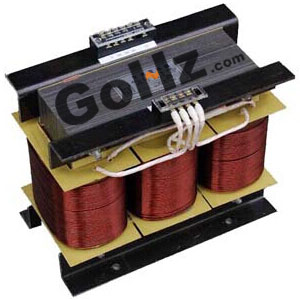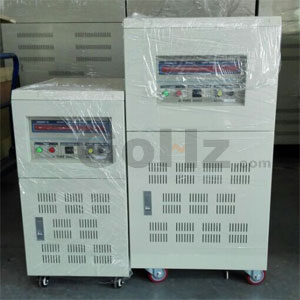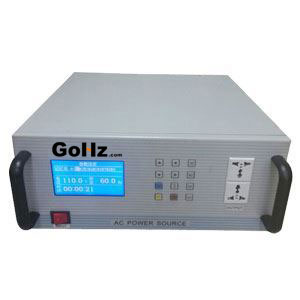Home » AC Power Source
The modern transformer isolated sine wave inverters can have either a 50/60 Hz or a 20-30 KHz transformer. In the old days, the best we could do was a few KHz switching frequency due to the poor components. We really weren't getting a sine wave out of the xmer, it was first filtered, so we were putting various switched rectangular waves that minimized harmonics and then filtered them. In modern ones, the xmer actually transfers true sine wave power at the output frequency of 50 Hz or 60 Hz. The H-bridge PWM output is low-pass filtered by an L-C filter and the xmer scales Vout to whatever voltage is needed (120 VAC or 240 VAC, etc.). Therefore, in the older types, we had higher core losses due to non-sinusoidal waveforms, whereas the modern types have nearly the same xmer core loss as powering them from the AC power line or an AC power source.
To put it simply, look at the name plate data and see if the machine is rated for 50 Hz / 60 Hz combination. If it is you can do that. If it is not, then you need to buy a 50/60 Hz motor for the operation. In the future when you buy a motor, make sure they are rated for both 50Hz & 60Hz frequencies. Then you won't have that problem.
We don't know the machine or supply voltage so all we are able to say for sure is, maybe. As you said, the 50Hz vs 60Hz are not a problem as long as the voltages maintain the proper V/Hz. The load is the final factor and since we don't know how much headroom he had in the original arrangement, all he can do is try it. It will either work or it won't but I'd try it before discarding the machine. Just trying it won't do any damage.
We don't know the machine or supply voltage so all we are able to say for sure is, maybe. As you said, the 50Hz vs 60Hz are not a problem as long as the voltages maintain the proper V/Hz. The load is the final factor and since we don't know how much headroom he had in the original arrangement, all he can do is try it. It will either work or it won't but I'd try it before discarding the machine. Just trying it won't do any damage.
 I hear comments on higher losses at the higher frequency. Derate this, derate that. All this derating talk. Comment after comment. I took some Tempel Steel M6 watts loss curves and turned them into their exponential expressions using log10 juggling to give an expression k*B^n1*f^n2. The equation is 6.1361E-6*(f)^1.6273*B^1.7784. f is in Hz, B is in kGauss. I used the 4kG curve and the 1 kG curve to derive the equation and then tried the equation out at 13.5kG and several frequencies, and it was accurate. From 50 Hz to 60 Hz, if you just plug the 50 Hz and 13.5 kGauss into the equation, and then try the equation with 60 Hz and 50/60 *14 or 11.25 kGauss, W/lb will be .365 and .355, respectively. ===>less watts loss on the core at 60Hz. What else happens?
I hear comments on higher losses at the higher frequency. Derate this, derate that. All this derating talk. Comment after comment. I took some Tempel Steel M6 watts loss curves and turned them into their exponential expressions using log10 juggling to give an expression k*B^n1*f^n2. The equation is 6.1361E-6*(f)^1.6273*B^1.7784. f is in Hz, B is in kGauss. I used the 4kG curve and the 1 kG curve to derive the equation and then tried the equation out at 13.5kG and several frequencies, and it was accurate. From 50 Hz to 60 Hz, if you just plug the 50 Hz and 13.5 kGauss into the equation, and then try the equation with 60 Hz and 50/60 *14 or 11.25 kGauss, W/lb will be .365 and .355, respectively. ===>less watts loss on the core at 60Hz. What else happens?
You can use 50Hz instead of 60Hz, here in my country the frequency is 60Hz and is very common that IEC (50Hz) motors work here without troubles. IEC motor frequency has been made oversize so the flux, warm or other factors in DOL will not be affected. Probably for a smaller motor it's yes. A larger one might not be able to handle the mechanical and electrical stresses at 60Hz.
You must consider the additional speed and make sure you do not exceed the HP/current rating. With a variable torque pump the load could go up by as much as 72% (60/50^3) rpm will change, for example at 60 Hertz will produce 3600 rpm,1800 rpm, 1200 rpm, 900 rpm. The number of poles is always in pairs. at 50 hertz, 3000 rpm, 1500 rpm, so on.
You must consider the additional speed and make sure you do not exceed the HP/current rating. With a variable torque pump the load could go up by as much as 72% (60/50^3) rpm will change, for example at 60 Hertz will produce 3600 rpm,1800 rpm, 1200 rpm, 900 rpm. The number of poles is always in pairs. at 50 hertz, 3000 rpm, 1500 rpm, so on.
Tags: 50Hz vs 60Hz
50Hz 60Hz Frequency Converter Setting
Using GoHz frequency converter to
Or customize your own converters.
- Convert 220v 50Hz to 110v 60Hz,
- Convert 120v 60Hz to 230v 50Hz,
- Convert 110v 60Hz to 240v 50Hz,
- Convert 480v 60Hz to 380v 50Hz,
- Convert 400v 50Hz to 460v 60Hz,
- Convert 240v 60Hz to 380v 50Hz,
Or customize your own converters.
Featured Articles
460v 60Hz motor on 400v 50Hz power ...
 Often the European motors at 1hp size are universal for 50Hz or 60Hz power supply, as long as you have 400V x 50Hz and 460V x ...
Often the European motors at 1hp size are universal for 50Hz or 60Hz power supply, as long as you have 400V x 50Hz and 460V x ...
 Often the European motors at 1hp size are universal for 50Hz or 60Hz power supply, as long as you have 400V x 50Hz and 460V x ...
Often the European motors at 1hp size are universal for 50Hz or 60Hz power supply, as long as you have 400V x 50Hz and 460V x ...Convert 220v, 230v, 240v 50Hz to 110v, ...
 When you buy an 110v (120v) 60Hz appliance from USA, and run it on 220v (230v, 240v) 50Hz country (i.e. UK, Australia, ...
When you buy an 110v (120v) 60Hz appliance from USA, and run it on 220v (230v, 240v) 50Hz country (i.e. UK, Australia, ...
 When you buy an 110v (120v) 60Hz appliance from USA, and run it on 220v (230v, 240v) 50Hz country (i.e. UK, Australia, ...
When you buy an 110v (120v) 60Hz appliance from USA, and run it on 220v (230v, 240v) 50Hz country (i.e. UK, Australia, ...60Hz motor running on 50Hz power ...
 Electric motors, both single and three phase, are designed for running on a specified power frequency. But sometimes we may use a ...
Electric motors, both single and three phase, are designed for running on a specified power frequency. But sometimes we may use a ...
 Electric motors, both single and three phase, are designed for running on a specified power frequency. But sometimes we may use a ...
Electric motors, both single and three phase, are designed for running on a specified power frequency. But sometimes we may use a ...